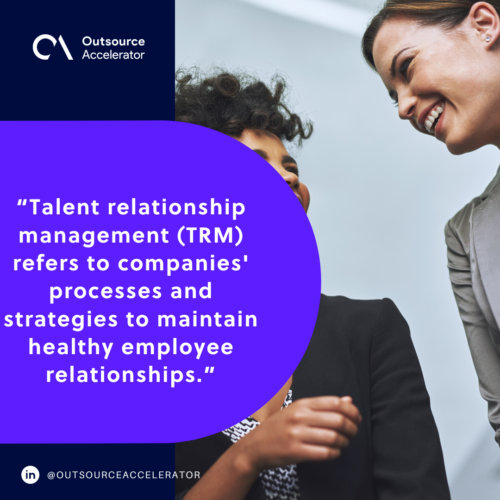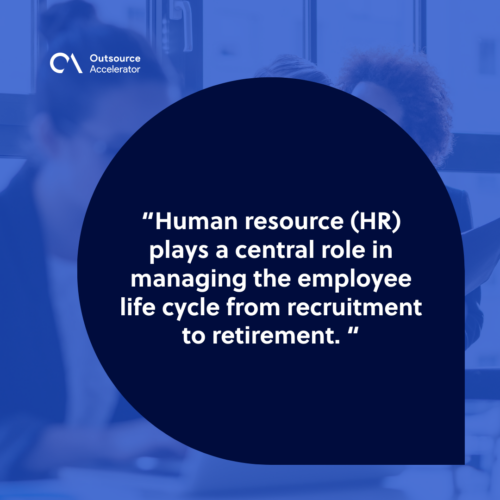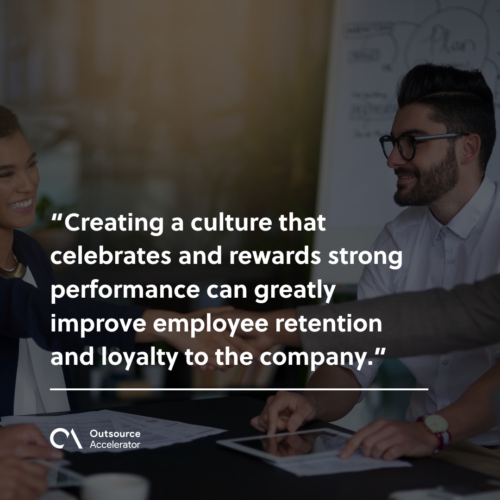Talent relationship management: The key to maintaining employee relationship

Employee retention and engagement are among the biggest concerns of businesses today.
Gone are the days when employees would stick with a company for their careers. Today, employees have more choices and opportunities, going to where their efforts are appreciated.
Talent relationship management goes beyond the traditional employee-employer relationship. It involves creating an employee-centric culture that values and nurtures the individual strengths of each employee.
By understanding their unique needs and aspirations, employers can create a work environment that fosters growth, development, and satisfaction.
Defining talent relationship management
Talent relationship management (TRM) refers to companies’ processes and strategies to maintain healthy employee relationships.
It involves engaging with employees throughout their life cycle, from recruitment to retirement. Generally speaking, it aims to create a positive employee experience and build a more loyal workforce.
TRM can also be managed using tools and metrics like customer relationship management.

Applicant tracking system vs. Talent relationship management
Many may confuse an applicant tracking system (ATS) with talent relationship management tools.
What distinguishes them is how it is used in each process of employee interaction.
An ATS manages the recruitment process. It gives insights into applicants based on their existing data, from their basic information to their work histories.
Meanwhile, talent relationship management looks at the longer relationship between a company and its employees.
It goes beyond hiring, including communication between management and staff, employee development, and managing employee exits.
Key players in talent relationship management
Talent relationship management is managed by the following key players to make it successful:
Senior leadership
The company’s management team sets the strategies and ideas for effective talent relationship management.
They set the tone for how the company values and treats its employees. Setting and maintaining the right culture is pivotal in creating a positive work environment and building trust within the staff.
Human resources
Human resource (HR) plays a central role in managing the employee life cycle from recruitment to retirement. They are responsible for bridging the needs and communications between the workers and the management.
As a part of their function, HR teams are always looking for ways to enhance employee engagement.

Supervisors and managers
Supervisors and managers are key players in day-to-day TRM. They ensure their team members have a safe, supportive, and productive work environment.
One of their functions in TRM includes managing and resolving conflicts in the workplace.
5 ways talent relationship management helps you
Talent relationship management not only benefits employees. It also gives you an advantage in building trust, increasing retention, and establishing your brand.
Here are five ways TRM can help you:
1. Increase employee retention
Companies prioritizing talent relationship management can have higher employee retention in the long run.
To achieve this, creating a culture that celebrates accomplishment, provides coaching, and provides growth opportunities is essential.
2. Improve productivity
When employees feel valued and appreciated, it is highly likely that they will be more productive.
Keeping them engaged and invested in their work helps ensure they will be more eager to put in more effort and achieve better results.
3. Enhance employer brand
Employers who adopt talent relationship management tend to be more attractive to prospective employees.
A positive and supportive work environment ensures employees speak highly of the company. This boost in employer branding gives them a higher chance of attracting new and top talent.
4. Reduce turnover costs
Employee turnover can be costly to a company’s resources. A company can greatly mitigate these costs by building a great employee experience and having a solid TRM plan.
5. Enrich employee satisfaction
Employees who feel their company truly cares about their well-being are more likely to be satisfied with their jobs. This leads to increased motivation and loyalty to the company.
Talent relationship management tools
Below are three talent relationship management tools organizations can use for a robust process:
HR information system (HRIS)
HRIS automates HR management processes. It is a great tool for managing HR data, such as personal information, attendance, performance, and exit management.
Employee engagement surveys
Employee engagement surveys are another great tool for measuring employee satisfaction and gauging how well HR has built employee loyalty.
Employees’ input helps HR make better decisions and refine their strategies.
E-learning tools
Employees need to grow and improve, and a great way to do that is through e-learning.
Companies can invest in e-learning platforms that provide courses, workshops, and on-demand training that help improve staff skills and efficiency.
Best practices in improving talent relationship management
Talent relationship management is essential at a time when employee engagement and retention have become big business. Companies must create a great employee experience to stimulate their engagement and retention.
Now is always a good time to improve talent relationship management and retention. The following are some of the best practices to do this:
- Communicate transparently. The basis of good talent relationship management is clear and transparent communication. This means providing employees with information on how the company is doing and how they are performing as individuals.
- Foster a positive culture. Creating a culture that celebrates and rewards strong performance can greatly improve employee retention and loyalty to the company.

- Recognize achievements. Acknowledging and rewarding employees’ achievements builds a culture of recognition and appreciation.
- Support employees’ growth and development. Companies should invest in employee development to give them the tools and skills they need to grow in their careers.
- Review and adapt TRM processes. TRM is not a one-time process but rather an ongoing one. Regular reviews will uncover weaknesses, which can be improved to create a more efficient TRM system.







 Independent
Independent




